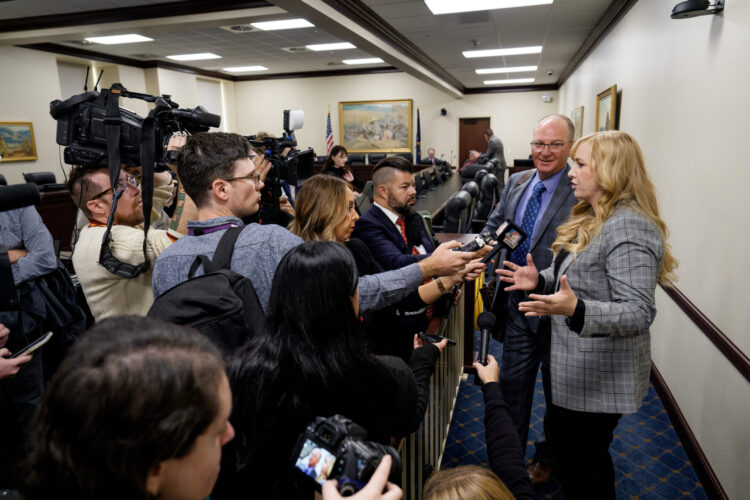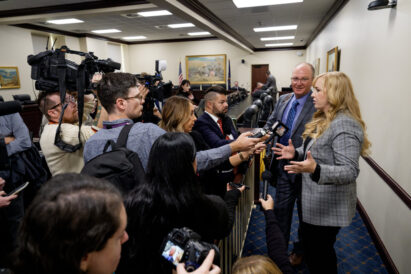Utah redistricting committee picks congressional map supported by Republican party
Republican-controlled Utah Legislature expected to vote on map C during special session later Monday to send to judge for consideration

Photo by Spenser Heaps for Utah News Dispatch
Sen. Scott Sandal, R-Tremonton, and Rep. Candice Pierucci, R-Riverton, talk to reporters after a meeting of the Utah Legislative Redistricting Committee during a special legislative session at the Capitol in Salt Lake City on Monday, Oct. 6, 2025.After little debate Monday morning but with Democrats voting against, the Utah Legislative Redistricting Committee voted to pick map C — a congressional map that the Utah GOP last week encouraged Republicans to support.
The map now goes to the full Republican-controlled Legislature to consider during a special session later Monday morning.
Lawmakers are expected to approve the map and send it to 3rd District Judge Dianna Gibson to consider in Utah’s court-ordered redistricting process, after Gibson determined the state’s 2021 congressional map was the product of an unconstitutional process. She ruled the Legislature overstepped when it repealed and replaced a voter-approved ballot initiative known as Proposition 4 that sought to create an independent redistricting process.
Map C would mix rural and urban parts of Utah, split three cities (Millcreek, North Salt Lake and Pleasant Grove) and split three counties (Davis, Salt Lake and Utah). The state’s Democratic stronghold and capital city of Salt Lake City would remain whole, while Salt Lake County (the state’s most populated county) would be split once.
Monday marked Utah lawmakers’ deadline to vote on and submit a map to the court for consideration. It’s the same deadline for plaintiffs in the state’s redistricting lawsuit that successfully challenged lawmakers’ override of Proposition 4 to submit their own proposed congressional map.
Under the 2021 congressional map, Salt Lake County was split four times — which led to a lawsuit from nonpartisan groups including the League of Women Voters of Utah, Mormon Women for Ethical Government and a handful of Salt Lake County voters challenging it as “blatant gerrymandering,” along with claims that lawmakers’ unconstitutionally repealed and replaced Proposition 4.
Map C would be more competitive for Democrats compared to the 2021 map — but would still result in four congressional districts that would lean in favor of the deep red state’s dominant party, the GOP.
Gibson is expected to ultimately pick a replacement map — either the Legislature’s preferred map or the plaintiffs’ — by her deadline of Nov. 10 in order for it to be put in place in time for the 2026 elections.
However, one of the Legislative Redistricting Committee’s co-chairs, Sen. Scott Sandall, R-Tremonton, told reporters if Gibson rejects map C and picks a map not drawn by lawmakers and instead drawn by plaintiffs, the Legislature will likely fight that decision in court as they continue to appeal Gibson’s earlier ruling before the Utah Supreme Court and potentially the U.S. Supreme Court.
“To be in compliance, to me, with code and the Constitution, the judge only has one option,” Sandall said, though he added she could “either accept this map or come back to the Legislature and say you failed … and you’ve got to develop a map that takes that into account. To me, it’s the Legislature’s responsibility, constitutionally, to do this.”
The Legislative Redistricting Committee’s only two Democrats — Senate Minority Leader Luz Escamilla, D-Salt Lake City, and Rep. Doug Owens, D-Millcreek — didn’t debate against map C during Monday’s committee hearing and cast their no votes without comment. Owens told Utah News Dispatch after the meeting that Democrats already made their case against the committee’s slate of five proposed maps and in favor of Democrats’ preferred map during two committee hearings last month.
“There was nothing new to say,” Owens said, though he and Escamilla told reporters they don’t believe map C adheres to Proposition 4’s standards because it was drawn using a statistical method that Democrats say unfairly benefits the dominant party, in this case Republicans.
Owens also said if the Republican Party’s preference of map C was taken into account during the legislative committee’s selection process, “that’s improper for the Legislature to take partisan outcome into consideration.”
Owens, however, added there has been “no evidence” that lawmakers were “swayed” by the party’s preference, “but I think it’s telling that the Republican Party itself publicly was pushing for that map because it was clearly the most damaging to Democrats.”
When asked whether the Republican Party’s support of map C influenced the Legislative Redistricting Committee’s selection, Sandall indicated he wasn’t aware of the party’s preference.
“Did the Republican party do that? Because quite honestly I’ve been shielded by all of that,” Sandall said.
The committee’s House co-chair, Rep. Candice Pierucci, R-Herriman, said it didn’t.
“I mean, we can’t control what happens in public comment, but I haven’t read that email. I’ve been asked that question over the past couple of days, but no,” she said, adding that while the party is “entitled to sharing their opinion, that didn’t come into consideration at all.”



